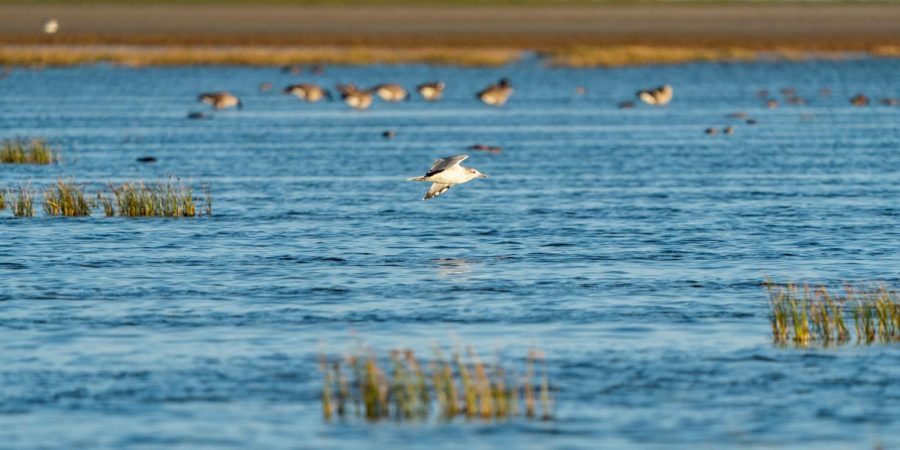News x The Globe – Utah Universities Work to Alleviate Water Crisis Through Conservation Efforts
A backflow prevention pipe at the University of Utah in Salt Lake City on Oct. 22, 2022. (Photo by Julia Chuang | The Daily Utah Chronicle)
November 9, 2022
Writers McCaulee Blackburn from The Globe and Jacob Freeman from the Daily Utah Chronicle produced this story together as part of the Chronicle’s November print issue focused on collaboration. This issue can be found in stands on the University of Utah’s campus as well as both publications’ websites.
Utah has a water problem.
2022 has been the driest year on record, according to the National Integrated Drought Information System. 79.12% of the state was in extreme drought or worse this past summer — and it’s affecting everything in the ecosystem, including the local population.
Universities in the state are each taking their own steps to address the water crisis. Weber State University created a Water Action Plan to optimize water use, Salt Lake Community College switched multiple irrigation systems, and the University of Utah is installing more efficient water fixtures in its buildings. All three are committed to water conservation efforts — and they’re all seeing results.
University of Utah
Kerry Case, the chief sustainability officer at the U, said a lot about water conservation can be learned by looking to schools throughout the Intermountain West, particularly other schools in drought-sensitive areas.
“This is of keen and unique importance to universities who are situated in arid regions,” Case said. “There is lots more we still need to do, and lots of plans to do more.”
University water conservation, among other indicators of sustainability, is tracked by the Sustainability Tracking, Assessment and Rating System. STARS serves as a database for self-reported sustainability indicators and allows people to see how their university stacks up against the rest. The U received a gold STARS rating of 65.48 in 2020 with WSU receiving a silver rating of 61.40 in 2022, though SLCC, UVU and BYU were not rated.
“The fact that we are demonstrating exemplary [STARS] performance in our improvement in water usage really indicates that the university is doing a good job in this space compared to our peers,” Case said.
Part of this rating came from the university’s decrease in water usage over the nine-year period from 2010-19.
Over this period, the U saw its water use per campus user drop by nearly 30%, despite an increase of about 4,000 campus users in the same time frame, according to the Association for the Advancement of Sustainability in Higher Education.
Case said this was achieved through numerous projects and initiatives on campus.
“Some of that is landscape conversion away from turf towards more water-wise landscaping, some of that is improvement in irrigation systems and controls,” Case said. “Some of that is also indoors, by both new construction with more water-efficient fixtures and retrofitting existing buildings with more water-efficient equipment.”
Case said she believes the U’s efforts in water conservation can impact the health of the Great Salt Lake, which has already shrunk by two-thirds, hitting a new record low this past summer when it dropped to 4,190.1 feet, according to the Utah Department of Natural Resources.
“We are part of a more sustainable path forward for the Great Salt Lake, not only through our operations … but also the way we contribute through research and education,” Case said.
If the lake continues to dry up, there would be several repercussions, including the lake’s flies and brine shrimp dying off, ski conditions at resorts deteriorating and the extraction of magnesium and other minerals from the lake potentially stopping, according to the New York Times. Most concerning, because the lake bed contains high levels of arsenic, “the air surrounding Salt Lake City would occasionally turn poisonous.”
One of the contributions from the U is achieved by the Wilkes Center for Climate Science and Policy, which works to keep state policymakers informed on the issues concerning the Great Salt Lake, according to Case.

Weber State University
WSU also expressed a commitment to water conservation.
Drew Hodge, the water conservation and Municipal Separate Storm Sewer System stormwater coordinator at WSU, said he is cheerful about the water conservation efforts at the college.
“Weber State has done a lot for water conservation,” Hodge said. “We recognize that water is an issue and that we’ve been in a long-term drought.”
WSU created his position in the late 2010s because of the need for better water management. Hodge said he started crafting a Water Action Plan as soon as he started at the university, which ended up taking more than a year to fully put together.
“We really tried to get any stakeholder that would be involved and has a reason to care about water on it,” he said.
Hodge said the Water Action Plan is broken down into three categories: culinary water (water used in buildings), secondary water (water used for irrigation) and stormwater. The plan integrated input from students, faculty, staff and people from the surrounding areas. WSU also created a water council that’s open to the public and meets annually.
According to Hodge, the water council created a list of goals that can be seen in the plan that were “realistic, but stringent.”
“We already knew what we needed to do, and we moved forward a little bit faster,” Hodge said. “It really set us up for success.”
Hodge said after being implemented, the plan helped them reduce their secondary water usage by half. WSU’s water conservation actions also include using the most efficient water practices available for any new development.
“We use EPA Water Sense Certified fixtures,” Hodge said. “That conserves the most water indoors.”
Hodge added that WSU is monitoring “distribution uniformity” from sprinklers to ensure water is distributed efficiently and that they “do regular water audits” to make sure the sprinklers are operating as effectively as possible.
WSU is also implementing xeriscaping, landscaping that requires little to no water, in certain areas on campus.
“We prioritize xeriscaping in areas where it does not make sense to have turf,” Hodge said.
He said WSU xeriscapes to save water on smaller areas, big hills and areas that aren’t gathered on by students and staff.
The university also created a program called Water Warriors to unite and reward WSU landscapers for water conservation projects.
“Everybody chooses an area that they are struggling with that performs poorly [with water use],” Hodge said. “We do a water audit on it. And then we supply some funds.”
After identifying an area on campus, Hodge said, they make an action plan to upgrade it. An additional audit is conducted to compare water use once the water conservation project is completed. The title Water Warrior is then awarded to the landscaper that has implemented the most water conservation that year. The university completes about 12-14 Water Warrior projects annually, Hodge said.
WSU’s unique campus also helps with water conservation, said Hodge. For example, the pond at WSU traps stormwater.
Hodge said the university also wants to help the Great Salt Lake while it’s in crisis.
“We put into the [Water Action Plan] that we want to be able to eventually allocate our unused water to get to the lake,” he said.
The water council will formulate a plan to accomplish this goal at their annual meeting this year.
Salt Lake Community College
Joel Evans, the grounds manager at SLCC, said the college has made recent changes to conserve water, including upgrading the irrigation system at two of its 10 campuses in 2020. A WeatherTRAK Irrigation System monitors water evaporation from sprinklers, among other things.
“It basically monitors daily the wind speed, the heat, the humidity,” Evans said. “It also takes into account what type of crop [is watered], which in our case is predominantly bluegrass, and makes an incremental adjustment on a daily basis.”
The Jordan, Redwood, South City and Westpoint campuses and the SLCC International Aerospace/Aviation Education Center all use this irrigation system, with plans for the new Herriman campus to use the system as well.
Smaller campuses, like the West Valley Center and the Miller campus, haven’t received this upgrade, but Evans asserted that the plan is for all campuses to use this irrigation system once funding is secured.
Evans said switching to this irrigation system simplified outdoor water conservation.
“We’re now able to monitor flow a lot better … giving us the ability to identify [when water isn’t being used efficiently] without having to check each individual zone,” Evans said. “It’s a little bit more effective and efficient.”
Recently, SLCC has emphasized xeriscaping, particularly within the Redwood campus, according to The Globe. The college has plans to prioritize xeriscaping even more by implementing it across campuses and significantly reducing grass on the Redwood campus.
“Right now our focus is on areas that aren’t really utilized … I guess low-usage areas, like parking lot islands,” Evans said. “We’ve made quite a bit of headway there.”
He said that “less than 10, but probably more than five” acres of turf grass will be removed.
SLCC also began a project in May 2022 to update the soccer field with “sports turf.” This type of turf is nonagricultural land which means it doesn’t require water and will significantly decrease outdoor water usage.














